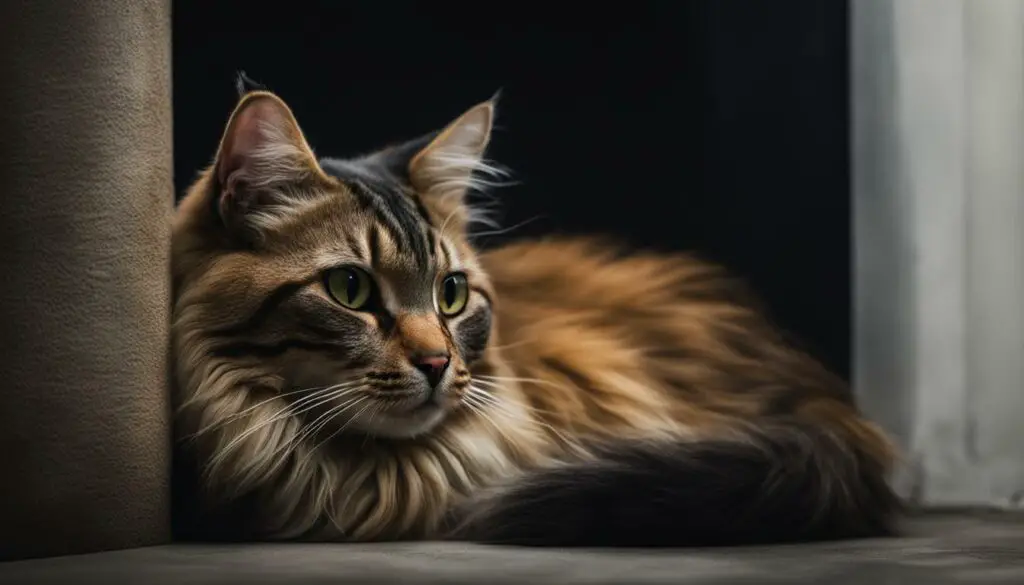Do you have a furry friend who gets anxious when you leave the house? If you’ve noticed your cat exhibiting signs of separation anxiety, you’re not alone. Cats can experience separation anxiety, especially if they have been orphaned or if there has been a change in their routine. It’s important to understand why your cat may be feeling this way and how you can help them cope.
Separation anxiety in cats can manifest in various ways, from excessive meowing to destructive behavior. Recognizing the signs and understanding the underlying causes is the first step in addressing this issue. In this article, I will guide you through the signs of separation anxiety in cats, the possible causes, and effective strategies to help your feline friend feel more secure and at ease.
Key Takeaways:
- Separation anxiety is common in cats, especially those who have experienced trauma or changes in their routine.
- Signs of separation anxiety in cats include excessive meowing, changes in eating habits, and destructive behavior.
- Causes of separation anxiety in cats can range from sudden changes in routine to being orphaned or weaned early.
- Strategies to help cats with separation anxiety include creating a safe space, providing enrichment activities, and gradual desensitization.
- Consulting a veterinarian is essential to rule out any underlying medical conditions and determine the best course of treatment.
Signs of Separation Anxiety in Cats
Cats can exhibit various signs when they are experiencing separation anxiety. It’s important to be aware of these signs to understand if your cat is suffering from this condition. Common signs include:
- Excessive vocalization: Cats may meow excessively or make loud noises when left alone.
- Changes in eating behavior: Some cats may stop eating or have a decreased appetite when they are anxious.
- Excessive self-grooming: Cats may excessively groom themselves as a coping mechanism for their anxiety.
- Elimination outside the litter box: Cats with separation anxiety may urinate or defecate outside their litter box.
- Destructive behavior: Cats may scratch furniture, chew on objects, or engage in other destructive behaviors when they are anxious.
- Excitement upon returning home: A cat with separation anxiety may display excessive excitement or clinginess upon your return.
- Vomiting: Some cats may vomit due to stress and anxiety caused by separation.
- Attempting to escape: Cats may try to escape from the house or find a way to reach their owners when they are anxious.
It is important to note that the signs of separation anxiety may vary from cat to cat, and not all cats will exhibit every sign. Observing your cat’s behavior and seeking veterinary advice can help confirm if your cat has separation anxiety.
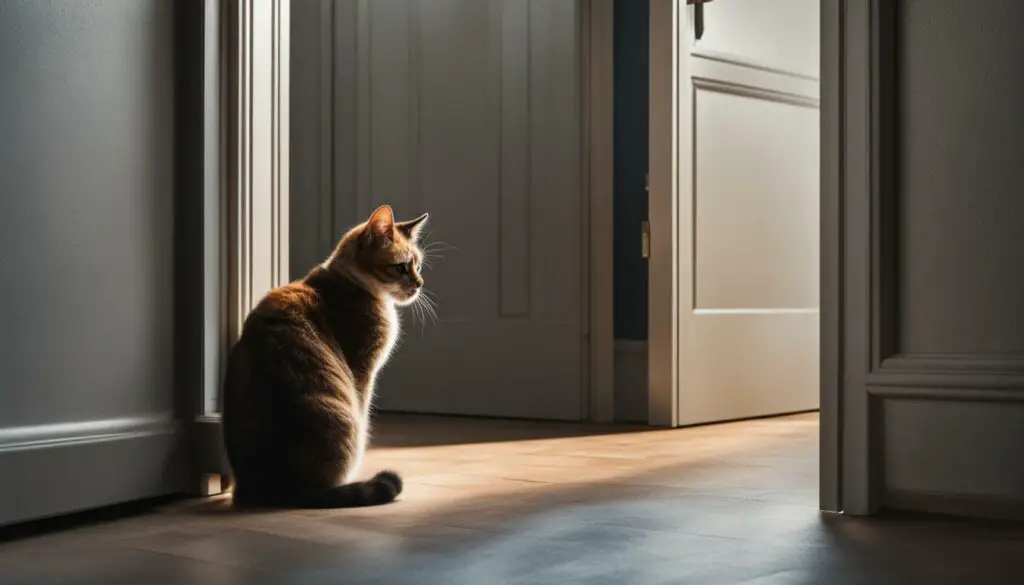
Table: Comparison of Common Signs of Separation Anxiety in Cats
| Signs of Separation Anxiety | Frequency | Severity |
|---|---|---|
| Excessive vocalization | High | Moderate to severe |
| Changes in eating behavior | Variable | Mild to severe |
| Excessive self-grooming | Variable | Mild to moderate |
| Elimination outside the litter box | Variable | Moderate to severe |
| Destructive behavior | Moderate | Moderate to severe |
| Excitement upon returning home | High | Mild to moderate |
| Vomiting | Low to moderate | Mild to moderate |
| Attempting to escape | Moderate | Moderate to severe |
Note: The frequency and severity of these signs may vary depending on the individual cat and their specific case of separation anxiety.
What Can Cause Separation Anxiety in Cats
Separation anxiety in cats can be caused by various factors that disrupt their sense of security and routine. Understanding these causes can help in effectively dealing with cat separation anxiety and implementing appropriate strategies for support.
Sudden Changes in Routine
Cats are creatures of habit and thrive on a consistent routine. Sudden changes in their daily schedule, such as a shift in feeding times or a disruption in their playtime, can trigger separation anxiety. It’s important to maintain a stable routine to help cats feel secure and reduce their anxiety levels.
Orphaned or Weaned Early
Cats who were orphaned at a young age or weaned early from their mothers may be more prone to separation anxiety. The loss of their primary caregiver and the nurturing environment that they would have experienced during the early stages of life can contribute to feelings of insecurity and anxiety when separated from their human companions.
Limited Social Interaction
Cats that live strictly indoors without the company of other pets may be more susceptible to separation anxiety. The lack of social interaction and companionship can lead to feelings of loneliness and isolation, making them more reliant on their human caregivers for emotional support.
Change in Ownership or Moving to a New Home
Changes in ownership or moving to a new home can be significant stressors for cats, leading to separation anxiety. Cats are highly territorial animals, and a change in their environment can disrupt their sense of familiarity and security. Providing a gradual transition and plenty of reassurance during these periods of change can help alleviate separation anxiety.

In conclusion, understanding the causes of separation anxiety in cats is essential for effective management and support. By addressing the underlying factors and implementing strategies to promote a sense of security and routine, cat owners can help their feline companions cope with separation anxiety and improve their overall well-being.
How to Help Your Cat with Separation Anxiety
If your cat is experiencing separation anxiety, there are several strategies you can use to help them feel more secure and relaxed when you’re not at home. Here are some effective ways to alleviate separation anxiety in cats:
1. Create a Safe Space for Your Cat
Set up a designated area where your cat can retreat to when they feel anxious or stressed. This can be a cozy corner with their bed, blankets, and toys. Make sure the space is quiet and away from any potential stressors like loud noises or sudden movements.
2. Provide Enrichment and Mental Stimulation
Engaging your cat’s mind and body can help alleviate their anxiety. Provide interactive toys, puzzle feeders, and scratching posts to keep them occupied while you’re away. Consider hiding treats or food around their safe space to encourage natural hunting behaviors.
3. Gradually Increase Alone Time
If your cat gets anxious as soon as you leave, gradually increase the amount of time they spend alone. Start with short absences and gradually extend the duration over time. This will help them build confidence and realize that you will always return.
4. Consider Calming Scents or Pheromones
Calming scents or pheromone diffusers can help create a sense of security in your cat’s environment. These products mimic the natural pheromones that cats release when they feel safe and secure. Consult with your veterinarian to determine the best option for your cat.
Remember, each cat is unique, and what works for one may not work for another. Be patient and persistent in finding the right strategies to help your cat cope with separation anxiety. If the anxiety persists or worsens, consult with your veterinarian for further guidance.
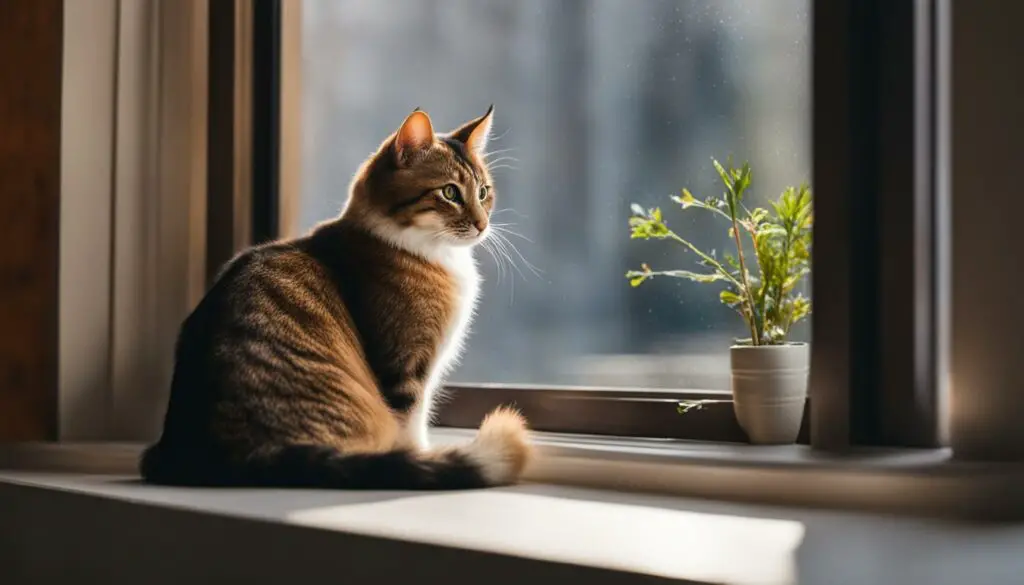
When to Consult a Veterinarian
If your cat is displaying signs of separation anxiety, it is important to consult a veterinarian for a proper diagnosis and guidance on treatment options. While separation anxiety is a common issue in cats, it can also be a symptom of underlying medical conditions. By seeking veterinary help, you can rule out any other potential health issues and ensure that your cat receives the appropriate care and support.
Consulting a veterinarian is particularly crucial if your cat’s behavior changes suddenly or if their symptoms are severe. Some cats may exhibit similar behaviors to separation anxiety when they have urinary tract infections or other health concerns, so it is essential to have a professional assessment. Your veterinarian will be able to conduct a thorough examination, ask relevant questions about your cat’s habits and environment, and recommend appropriate treatment options.
Remember, your veterinarian is your partner in helping your cat cope with separation anxiety. They have the knowledge and experience to provide you with expert advice and guidance. By working together, you can develop a personalized plan to alleviate your cat’s anxiety and improve their overall well-being.

Understanding Cats and Separation-Related Behavior
Cats are unique creatures with their own personalities and behaviors. While they may be more independent compared to dogs, cats can still experience separation-related behaviors and frustration when their routine is suddenly changed. Even if you leave your cat with someone at home, they may still exhibit signs of separation anxiety. It’s essential to understand your cat’s underlying emotions and how they are coping with any sudden changes.
Cats are naturally territorial and derive comfort from their familiar surroundings. When their routine is disrupted, they may feel stressed and anxious. Signs of separation-related behavior in cats can range from restlessness and excessive vocalization to hiding more than usual and toileting outside the litter tray. Cats may also show signs of excessive scratching or become startled by loud noises. In extreme cases, they may even experience vomiting or diarrhea as a response to their anxiety.
Understanding your cat’s behavior and emotions can help you address their separation anxiety effectively.
Creating a safe and secure environment is crucial for managing separation-related behaviors in cats. Providing enrichment activities, such as interactive toys and puzzle feeders, can keep their minds occupied while you are away. Additionally, ensuring access to safe outdoor spaces or providing perches for them to observe their surroundings can help alleviate stress. Keeping arrivals and departures low-key can also prevent heightening their anxiety levels.
By understanding and addressing your cat’s separation-related behavior, you can provide them with the support and care they need. Remember that each cat is unique, and it may take time and patience to find the right strategies that work for them. Consult with a veterinarian for further guidance and explore behavior modification techniques, environmental management, and, if necessary, medical interventions to help your cat cope with separation anxiety.

Identifying Separation Anxiety in Cats
To identify separation anxiety in cats, it is important to look for certain signs and symptoms that indicate their distress and anxiety when left alone. Cats may express their separation anxiety through various behaviors and physical reactions. Here are some common signs to watch out for:
Restlessness and Excessive Vocalization
When cats experience separation anxiety, they may become restless and display increased vocalization. They may meow excessively, yowl, or make other vocal sounds to express their distress and attempt to communicate their need for attention and companionship.
Refusing Food and Hiding
A cat with separation anxiety may refuse food even when they would normally eat. They may also hide in unusual places, seeking shelter and security as a response to their anxiety. Hiding is their way of finding solace and reducing their exposure to potential threats while feeling vulnerable.
Toileting Outside the Litter Tray
Another sign of separation anxiety in cats is toileting outside the litter tray. They may urinate or defecate in inappropriate places as a result of their anxiety and stress. This behavior can be frustrating for cat owners, but it is essential to understand that it is a symptom of their distress.
Excessive Scratching and Destructive Behavior
Cats with separation anxiety may resort to excessive scratching and destructive behavior as a way to cope with their anxiety. They may scratch furniture, walls, or doors, and chew or shred household items. These destructive behaviors are often a result of their frustration and attempts to alleviate their anxiety.
It is important to note that while these signs and symptoms can indicate separation anxiety in cats, they may also be indicative of other medical or behavioral issues. If you notice any of these signs in your cat, it is recommended to consult with a veterinarian for a proper diagnosis and guidance on how to address your cat’s separation anxiety.
Treatment Options for Separation Anxiety in Cats
When it comes to treating separation anxiety in cats, there are several options available that can help alleviate their distress and improve their overall well-being. These treatment options focus on environmental management, behavior modification, and, in some cases, medical intervention.
Environmental Management Strategies
Creating a calming environment is essential for cats with separation anxiety. This can be achieved by providing enrichment activities that stimulate their natural instincts. Puzzle feeders and interactive toys can keep them mentally engaged while you’re away. Additionally, having a safe space or “catio” where they can retreat to can help reduce their anxiety. Consider using pheromone diffusers or calming products to create a soothing atmosphere in their surroundings.
Behavior Modification Techniques
Behavior modification techniques can be highly effective in managing separation anxiety in cats. This involves desensitizing and counterconditioning them to departures and arrivals. Start by leaving for short periods and gradually increasing the duration to help them become more comfortable with your absence. Provide positive reinforcement, such as treats or praise, for calm behavior before and after your departures. Relaxation exercises, such as gentle massage or music therapy, can also help them relax and feel more secure.
Medical Intervention
In severe cases of separation anxiety, medication may be necessary to help cats cope with their anxiety. A veterinarian may prescribe anti-anxiety medications or supplements to reduce their stress levels. It’s important to work closely with your vet to determine the best course of action and monitor your cat’s response to treatment. Medication should always be considered as a last resort and used in conjunction with environmental management and behavior modification strategies.
By implementing a combination of these treatment options, you can provide your cat with the support they need to overcome separation anxiety. Remember to be patient and consistent in your approach, as it may take time for your cat to adjust. With the right care and treatment, you can help your furry friend feel more secure and content when left alone.
| Treatment Options | Description |
|---|---|
| Environmental Management | Creating a calming environment through enrichment activities, safe spaces, and the use of pheromone diffusers or calming products. |
| Behavior Modification Techniques | Gradually desensitizing and counterconditioning the cat to departures and arrivals, using positive reinforcement and relaxation exercises. |
| Medical Intervention | Prescribing anti-anxiety medications or supplements in severe cases, in conjunction with other treatment strategies. |
The Importance of Routine and Enrichment
Establishing a regular routine and providing enrichment activities are crucial in helping cats with separation anxiety. Cats thrive on routine, so keeping a consistent schedule of feeding times, playtimes, and rest times can help them feel more relaxed. This routine provides a sense of stability and predictability, which can reduce anxiety and stress.
Enrichment activities are essential for keeping cats mentally and physically stimulated while you’re away. Interactive toys, puzzle feeders, and scratching posts are great options to provide entertainment and exercise. These activities help redirect their energy and focus, preventing boredom and destructive behaviors that may arise from separation anxiety.
Additionally, creating a safe and comfortable space for your cat can also help alleviate their anxiety. This can be a designated area with cozy bedding, hiding spots, and familiar scents. Providing a perch or a “catio” that allows them to observe the outside world can also provide mental stimulation and reduce anxiety.
| Benefits of Routine and Enrichment for Cats with Separation Anxiety |
|---|
| 1. Reduced stress: A regular routine and enriching activities help cats feel secure and comfortable, reducing their overall stress levels. |
| 2. Mental stimulation: Enrichment activities engage their natural instincts and keep their minds active, preventing boredom and anxiety. |
| 3. Physical exercise: Playtime and interactive toys provide an outlet for physical energy, preventing destructive behaviors due to anxiety or pent-up energy. |
| 4. Distraction from separation: Having a routine and engaging in enrichment activities can distract cats from their anxiety during times of separation. |
Remember that every cat is unique, so it may take some trial and error to find the routine and enrichment activities that work best for your furry friend. Observe their behavior and adjust accordingly to ensure they feel supported and comfortable when you’re not around.
By prioritizing routine and providing enrichment, you’re taking important steps towards helping your cat overcome separation anxiety and fostering a happier, healthier, and more secure feline companion.

The Role of Environment in Managing Separation Anxiety
Cats are highly sensitive creatures, and their environment plays a crucial role in managing separation anxiety. By providing a comfortable and secure space, you can help alleviate their anxiety and create a calming atmosphere for them. Here are some key factors to consider:
Creating a Safe and Enriching Space
One effective way to manage separation anxiety in cats is by creating a safe and enriching space for them. This can be achieved by providing plenty of hiding spots, such as cat trees or cozy beds, where they can retreat when they feel anxious. Additionally, offering a variety of interactive toys and puzzles can help keep their minds engaged and alleviate boredom. In some cases, creating a designated “safe room” with their essential resources, such as food, water, litter box, and toys, can provide them with a sense of security during your absence.
Ensuring Access to the Outdoors
If it is safe and appropriate for your cat, allowing them access to the outdoors can have a positive impact on their anxiety levels. Outdoor time provides cats with mental and physical stimulation, allowing them to explore their surroundings, bask in the sun, and engage in natural behaviors. However, it’s essential to ensure that your cat is supervised and protected from any potential dangers, such as traffic or other animals.
Keeping Departures and Arrivals Low Key
When leaving or returning home, it’s important to keep things calm and low key. Cats are highly perceptive animals, and they can pick up on your emotions. If you make a big fuss when leaving or arriving, it can heighten their anxiety. Instead, try to maintain a routine and avoid making your departures and returns overly dramatic. By doing so, you can help create a sense of normalcy and reduce their separation anxiety.
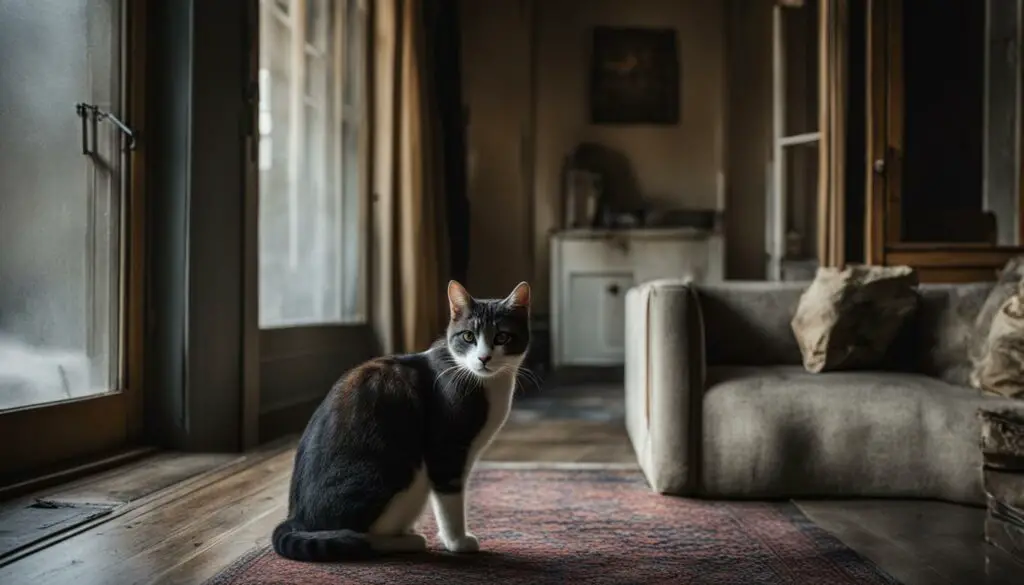
Conclusion
Managing separation anxiety in cats requires a holistic approach, with the cat’s environment playing a crucial role. By creating a safe and enriching space, allowing access to the outdoors (if safe), and keeping departures and arrivals low key, you can help minimize their anxiety and promote their overall well-being. Remember, each cat is unique, so it’s important to observe their behavior and make adjustments accordingly. With patience, understanding, and a supportive environment, you can help your cat cope with separation anxiety and lead a happier, more relaxed life.
The Role of Medical Intervention
When dealing with cat separation anxiety, there are various treatment options available, including medical intervention. In some cases, supplements or medications may be prescribed by a veterinarian to help reduce anxiety levels and manage the symptoms of separation anxiety in cats. It is crucial to work closely with your vet to determine the best course of action for your cat’s specific needs.
Medical intervention can be particularly beneficial for cats with severe separation anxiety or those who do not respond well to behavior modification techniques alone. Medications such as anti-anxiety drugs or pheromone-based products can help alleviate anxiety and provide relief for your furry friend.
It’s important to note that medication should typically be used as a last resort and under the supervision of a veterinarian. Your vet will carefully evaluate your cat’s health, behavior, and specific needs before recommending any medications. They will also monitor your cat’s response to treatment and make any necessary adjustments along the way.
Remember, every cat is unique, and what works for one may not work for another. Therefore, it is essential to consult with a professional to ensure the proper diagnosis and treatment plan for your cat’s separation anxiety.

| Treatment Options | Benefits |
|---|---|
| Supplements | Can help promote relaxation and reduce anxiety levels |
| Anti-anxiety medications | Can provide relief for cats with severe separation anxiety |
| Pheromone-based products | Can help create a calming environment and reduce stress |
| Behavior modification techniques | Can be used in conjunction with medical intervention to reinforce positive behaviors |
Avoiding Common Mistakes
When dealing with separation anxiety in cats, it’s important to avoid common mistakes that can hinder their progress and well-being. By being aware of these pitfalls, you can better support your feline companion during this challenging time.
Getting Another Cat as a Solution
While the idea of adopting another cat may seem like a good solution, it is not always the best approach for cats with separation anxiety. Introducing a new cat into the household can sometimes add to their stress and anxiety, especially if they have not had positive experiences with other cats in the past. It’s essential to address the root causes of their anxiety and provide individualized care and attention rather than relying on another cat to alleviate their separation anxiety.
Using Punishment or Confinement to Deal with Anxious Behavior
Punishing or confining your cat as a response to their anxious behavior can have negative consequences and may escalate their anxiety further. Cats do not understand punishment in the same way that humans do, and it can lead to fear, stress, and even worsen their separation anxiety. Instead, focus on positive reinforcement and reward-based training techniques to encourage desirable behaviors and help them feel more secure and relaxed.
Expecting Drastic Changes Overnight
Addressing separation anxiety in cats takes time and patience. It’s essential to understand that progress may not happen overnight and that each cat’s response to treatment may vary. Avoid setting unrealistic expectations and give your cat the time they need to adjust and learn new coping mechanisms. Consistency, positive reinforcement, and gradual desensitization are key in helping them overcome separation anxiety.
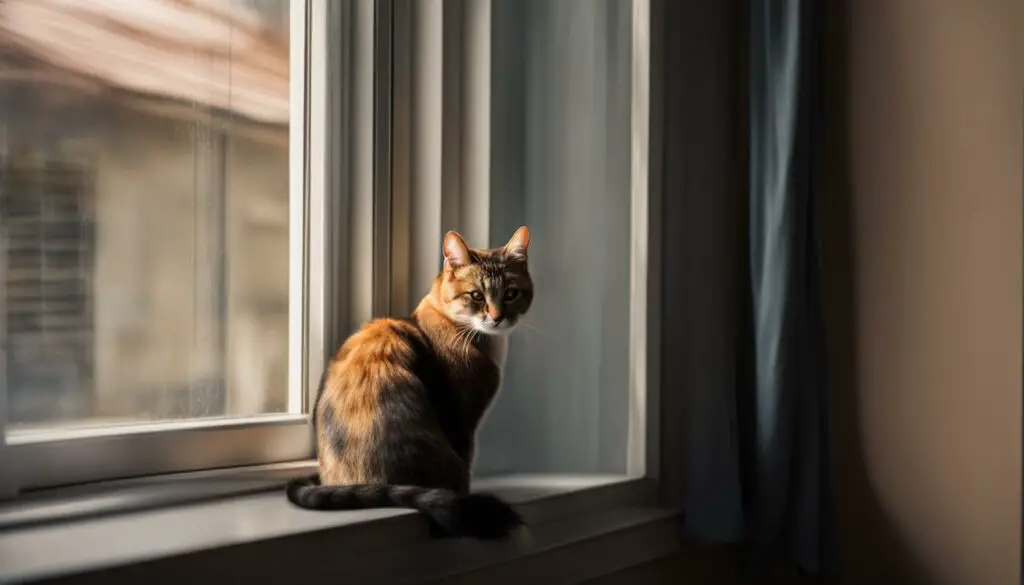
| Mistake | Why It’s a Mistake | Alternative Approach |
|---|---|---|
| Getting another cat as a solution | May add to the stress and anxiety of the cat | Address root causes of anxiety and provide individualized care |
| Using punishment or confinement | Can escalate anxiety and lead to fear and stress | Focus on positive reinforcement and reward-based training techniques |
| Expecting drastic changes overnight | Progress takes time and each cat’s response may vary | Be patient, consistent, and gradually desensitize the cat to separation |
Preventing Separation Anxiety in Cats
Preventing separation anxiety in cats requires taking proactive steps to create a supportive and stress-free environment for your furry friend. By understanding their needs and implementing preventive measures, you can minimize the chances of separation anxiety developing. Here are some strategies to consider:
- Choose confident and well-socialized cats: When adopting or selecting a cat, look for those that demonstrate confidence and ease in new situations. Socialized cats are more likely to adapt well to changes in routine and be less prone to separation anxiety.
- Maintain consistent routines: Cats thrive on predictability, so it’s essential to establish a consistent daily routine. This includes regular feeding times, playtimes, and rest periods. Consistency can help reduce stress and provide a sense of security.
- Encourage independence: While cats enjoy companionship, it’s important to encourage their independence. Provide opportunities for solo play, exploring, and resting in different areas of the house. This can help prevent over-reliance on human interaction and reduce anxiety when left alone.
- Create a low-key departure and return routine: When leaving or returning home, keep your interactions with your cat calm and low-key. This can help reduce their excitement or anxiety surrounding your departures and arrivals.
While these measures can help prevent separation anxiety in cats, it’s important to remember that every cat is unique. Some cats may be more prone to anxiety than others, and certain life events or changes in routine can still trigger separation anxiety. Early diagnosis and intervention are crucial in managing separation anxiety and ensuring your cat’s well-being.
To summarize, by selecting well-socialized cats, maintaining consistent routines, encouraging independence, and establishing a low-key departure and return routine, you can take proactive steps to prevent separation anxiety in your feline companion.
Preventive Measures for Separation Anxiety in Cats
In addition to the strategies mentioned above, here are some additional preventive measures to consider:
- Gradual desensitization: If you anticipate a change in routine or an upcoming event that may cause stress, gradually expose your cat to the new situation in small steps. This can help them adjust and reduce the likelihood of separation anxiety.
- Provide mental and physical stimulation: Engaging your cat in regular play sessions, puzzle feeders, and interactive toys can help keep their minds active and alleviate boredom. Mental and physical stimulation can promote relaxation and decrease anxiety.
- Consider a companion animal: In some cases, having a compatible companion animal can help alleviate separation anxiety. However, it’s essential to introduce a new pet gradually and ensure they get along well before leaving them alone together.
By taking a proactive approach and implementing these preventive measures, you can create a supportive environment that reduces the likelihood of separation anxiety in your beloved feline companion.
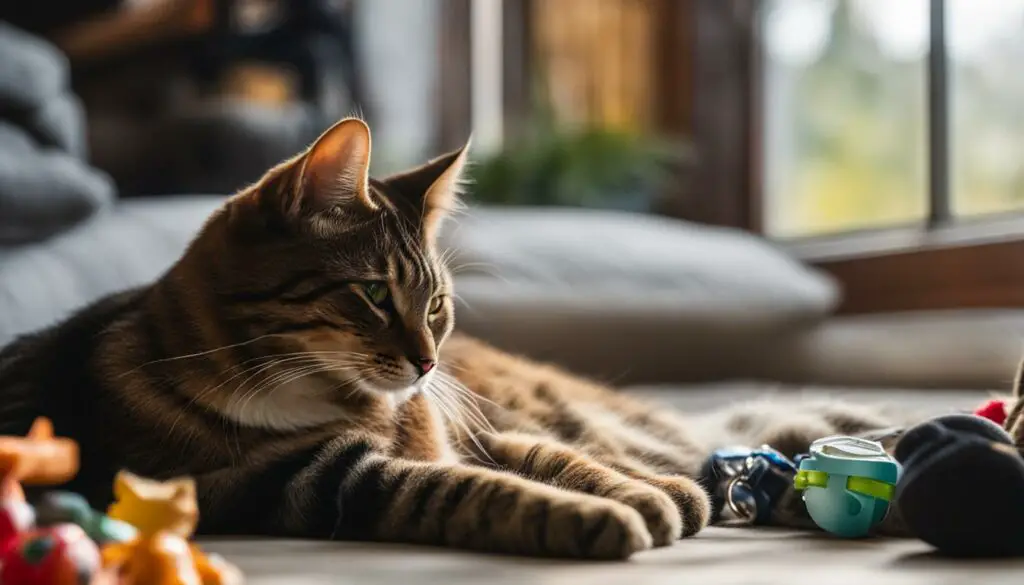
Table: Summary of Preventive Measures for Separation Anxiety in Cats
| Preventive Measures | Description |
|---|---|
| Choose confident and well-socialized cats | Opt for cats that demonstrate confidence and ease in new situations, reducing the likelihood of separation anxiety. |
| Maintain consistent routines | Establish a regular schedule for feeding, playtime, and rest to provide a sense of security and reduce stress. |
| Encourage independence | Offer opportunities for solo play, exploring, and resting in different areas of the house to prevent over-reliance on human interaction. |
| Create a low-key departure and return routine | Maintain calm and low-key interactions during departures and arrivals, minimizing anxiety or excitement. |
| Gradual desensitization | Expose cats to new situations gradually to help them adjust and reduce the likelihood of separation anxiety. |
| Provide mental and physical stimulation | Engage cats in regular play sessions, puzzle feeders, and interactive toys to keep their minds active and alleviate boredom. |
| Consider a companion animal | In some cases, a compatible companion animal can help alleviate separation anxiety, but introductions should be gradual and supervised. |
Conclusion
Having a cat with separation anxiety can be challenging, but with the right approach and understanding, you can help your furry friend feel more at ease. By recognizing the signs of separation anxiety in cats, such as excessive meowing or destructive behavior, you can take steps to alleviate their stress.
Creating a safe and enriched environment is crucial in managing separation anxiety. Establishing a routine, providing mental and physical stimulation through toys and puzzles, and ensuring access to safe outdoor spaces can all help your cat feel more secure and content.
If your cat’s separation anxiety is severe and other strategies haven’t been effective, it may be necessary to consult a veterinarian. They can provide guidance on behavioral modification techniques or recommend supplements or medications to reduce anxiety levels.
Remember, patience and consistency are key when helping a cat with separation anxiety. By understanding their needs and providing the right support, you can create a happier and more relaxed environment for your beloved feline companion.
FAQ
What are the signs of separation anxiety in cats?
Signs of separation anxiety in cats can include excessive vocalization, changes in eating behavior, excessive self-grooming, elimination outside the litter box, destructive behavior, excitement upon returning home, vomiting, and attempting to escape.
What can cause separation anxiety in cats?
Separation anxiety in cats can be caused by factors such as sudden changes in routine, being orphaned or weaned early, living strictly indoors without other pets, and experiencing a change in ownership or moving to a new home.
How can I help my cat with separation anxiety?
Strategies to help cats with separation anxiety include leaving the radio or TV on, keeping arrivals and departures low key, creating a safe space for the cat, providing toys and puzzles for playtime, hiding food in toys, starting with shorter absences first, providing a perch or “catio,” considering the use of calming scents or pheromones, removing departure cues, and providing plenty of cuddles and playtime once you’re home.
When should I consult a veterinarian for my cat’s separation anxiety?
If your cat is showing signs of separation anxiety, it’s important to consult a veterinarian to rule out any underlying medical conditions. Some cats may exhibit similar behaviors when they have urinary tract infections or other health issues. Consulting a veterinarian can help provide a proper diagnosis and guidance for treatment.
How can I identify separation anxiety in cats?
Signs of separation anxiety in cats can include restlessness, excessive vocalization, being startled by loud noises, refusing food, hiding more than usual, toileting outside the litter tray, excessive scratching, and in extreme cases, vomiting or diarrhea.
What are the treatment options for separation anxiety in cats?
Treatment options for separation anxiety in cats include environmental management, the use of pheromone diffusers or calming products, behavior modification techniques, and in some cases, medication.
How important is routine and enrichment for cats with separation anxiety?
Establishing a regular routine and providing enrichment activities are crucial in helping cats with separation anxiety. Cats thrive on routine, so keeping a consistent schedule of feeding times, playtimes, and rest times can help them feel more relaxed. Enrichment activities, such as puzzle feeders and interactive toys, can provide mental and physical stimulation while you’re away.
What is the role of the environment in managing separation anxiety in cats?
Managing the environment plays a significant role in minimizing separation anxiety in cats. Providing enrichment activities, creating safe spaces for the cat, and ensuring access to the outdoors (if safe) can help them feel more secure. It’s also important to keep arrivals and departures low key to avoid heightening their anxiety.
When is medical intervention necessary for cats with separation anxiety?
In some cases, medical intervention may be necessary to help cats with separation anxiety. Supplements or medications may be prescribed by a veterinarian to reduce anxiety levels. It’s important to work closely with your vet to determine the best course of action and monitor your cat’s response to treatment.
What are common mistakes to avoid when dealing with cat separation anxiety?
Common mistakes to avoid when dealing with cat separation anxiety include getting another cat as a solution, using punishment or confinement to deal with anxious behavior, and expecting drastic changes overnight. Understanding the nature of separation anxiety and following appropriate strategies can lead to better outcomes.
Can separation anxiety in cats be prevented?
While there is no guaranteed way to prevent separation anxiety in cats, some steps can decrease the chances. Selecting confident and well-socialized cats, keeping routines consistent, encouraging independence, and creating a low-key departure and return routine are some preventive measures. Early diagnosis and treatment are also important for better outcomes.
How can I improve my cat’s overall well-being while dealing with separation anxiety?
By creating a stress-free environment, maintaining a routine, providing enrichment activities, and seeking appropriate medical intervention if necessary, you can help your cat cope with separation anxiety and improve their overall well-being.

